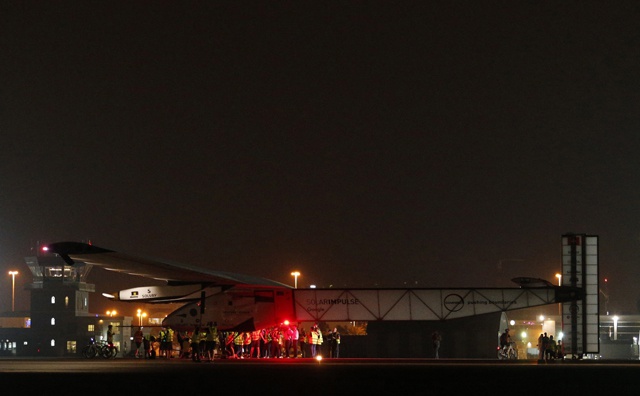Solar plane completes epic round-the-world trip

Solar Impulse 2, the solar powered plane, arrives at Al Batin Airport in Abu Dabi to complete its world tour flight on July 26, 2016 in the United Arab Emirates. (KARIM SAHIB/AFP)
(AFP) - Solar Impulse 2 on Tuesday completed its historic round-the-world journey, becoming the first airplane to circle the globe powered only by the sun to promote renewable energy.
Cheers and applause broke out as the plane touched down before dawn in Abu Dhabi after the final leg of its marathon trip which began on March 9 last year.
Swiss explorer and project director Bertrand Piccard was in the cockpit during the more than 48-hour flight from Cairo, crossing the Red Sea, the vast Saudi desert and flying over the Gulf.
It capped a remarkable 43,000-kilometre (26,700-mile) journey across four continents, two oceans and three seas, accomplished in 23 days of flying without a drop of fuel.
"The future is clean, the future is you, the future is now, let's take it further," Piccard said as he disembarked.
"One thing I would like for you to remember: More than an achievement in the history of aviation, Solar Impulse has made an achievement in (the) history of energy," he said.
"We have enough solutions, enough technologies. We should never accept the world to be polluted only because people are scared to think in another way."
Hours before landing, UN Secretary General Ban Ki-moon lavished praise on the team in a live-streamed conversation.
"My deepest admiration and respect for your courage," he said. "This is a historic day, not only for you but for humanity."
- 'Achieve the impossible' -
Dubbed the "paper plane", Solar Impulse 2 circumnavigated the globe in 17 stages, with 58-year-old Piccard and his compatriot Andre Borschberg taking turns at the controls of the single-seat aircraft.
Borschberg, 63, smashed the record for the longest uninterrupted solo journey in aviation history between Nagoya, Japan and Hawaii that lasted nearly 118 hours and covered 8,924 kilometres last year.
No heavier than a car but with the wingspan of a Boeing 747, the four-engine, battery-powered aircraft relies on around 17,000 solar cells embedded in its wings.
The plane clocked an average speed of 80 kilometres an hour (50 miles per hour).
The pilots used oxygen tanks to breathe at high altitude and wore suits specially designed to cope with the extreme conditions.
They have had to withstand temperatures inside the tiny cockpit ranging from minus 20 degrees to plus 35 degrees C (minus 4 degrees to plus 95 degrees F).
Piccard has said he launched the project in 2003 to show that renewable energy "can achieve the impossible".
His dream has taken much longer than planned. The attempt was initially expected to last five months, including 25 days of actual flying.
But the aircraft was grounded in July last year when its solar-powered batteries suffered problems halfway through the trip.
- 'Really exhausting' -
The project was also beset by bad weather and illness, which forced Piccard to delay the final leg.
While in the air, the pilot was constantly in contact with mission control in Monaco, where a team of weathermen, mathematicians and engineers monitored the route and prepared flight strategies.
A psychiatrist who made the first non-stop balloon flight around the world in 1999, Piccard had warned the last leg would be difficult because of the high temperatures.
"It's been two hours now I'm flying into high up and down drafts. And I can't even drink. It's really exhausting," he tweeted on Sunday.
But he did not show signs of fatigue when he landed.
"It was a project that was very difficult, a lot of people doubted we could do it, so of course for the team it's fantastic but also for all the people who believe in clean technologies," Piccard told reporters after landing.
While the pilots do not expect commercial solar-powered planes any time soon, they hope the project will help spur wider progress in clean energy.
"We can hardly believe that we made it. It's still a little bit like in a dream. We have to realise that it's the reality," Piccard said.
"Now the trip around the world has been done, and there is one thing less that is impossible in the world," he added.
© 1994-2016 Agence France-Presse





